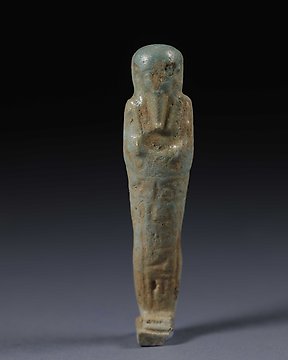
Altes Ägypten, Ptolemäisch Fayence Ushabti - 10 cm
Nr. 81563749

Nr. 81563749

A fine Egyptian mummy mask made of small faience beads, restrung in their original arrangement. The large trapezoid eyes, long thin eyebrows, broad nose and round small mouth displays symmetrical quality in perfection. The mask has a tripartite panel under the chin of the mask, which shows a beaded composition in the forms of a winged scarab, rendered in multi-coloured faience beads. Under the beaded scarab are the four Sons of Horus, arranged facing each other in pairs. Composition of such enlarged groups including the face, winged scarab and the Sons of Horus are generally rare. Elongated faience beads frame the entire composition.
The mummy mask was placed over the face of the deceased at their burial, mostly for decorative or protective purposes. Their un-naturalistic features make it improbable that they are modelled after the face of the deceased individual. Rather, they more likely depicted generic image of a human face. Their blue-greenish colour also suggested such masks may serve as visual representations of the god Osiris, as this colour was normally reserved for the depiction of the god of death on the walls of the tombs. According to mythology, the Four Sons of Horus each were attributed a different organ to protect. For instance, Imsety for liver, Duamutef for stomach, Hapi for the lungs, and Qebehsenuef for the intestines.
Measurements: Circa L 23.5cm x W 13.8cm
Provenance: from Mariaud de Serres collection, Paris 1980s-90s.
So kaufen Sie auf Catawiki
1. Etwas Besonderes entdecken
2. Höchstgebot abgeben
3. Sichere Zahlung durchführen